No Bake Chocolate Peanut Butter Granola Bars
You’re going to love these tasty, No Bake Chocolate Peanut Butter Granola Bars by Ashley from Spoonful of Flavor. They’re the healthy way to start your day!
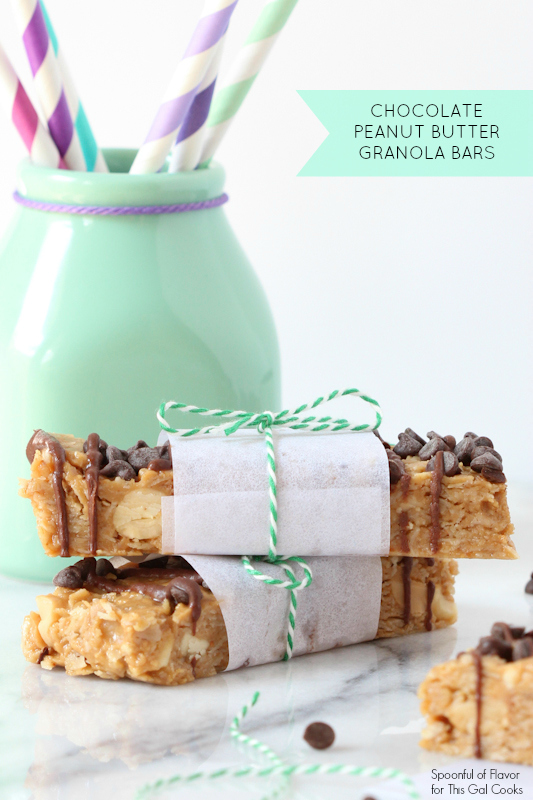
No Bake Chocolate Peanut Butter Granola Bars
Hi everyone! I’m Ashley from Spoonful of Flavor and I am very excited to be guest posting today on This Gal Cooks. I love creating recipes that are easy and perfect for the entire family. I’ve been known to indulge in something sweet every now and then, and you won’t ever find me without chocolate and a stash of snacks. Today, I have the perfect no-bake snack to share with you. These no-bake chocolate peanut butter granola bars are chewy, gooey and loaded with peanut butter flavor.
Do you love to snack? Most days, I have an afternoon snack and a post-dinner evening snack. And I always try to include chocolate. In reality, I probably snack more than I should. Sometimes, I don’t actually eat three meals in a day, but rather substitute one of the meals for a few snacks instead. I still try to keep the snacks wholesome and balanced. But as much as I love to bake, during the week, I rarely have time to bake at all. So, I’m always looking for fun no-bake snacks. These no-bake chocolate peanut butter granola bars are the perfect snack for the entire family.
I love incorporating granola bars into my snack options. And I always try new flavors and varieties. These granola bars are perfect for the peanut butter lover, with a double dose of peanut flavor. Chunks of peanuts and chocolate chips add a subtle crunch. The coconut oil gives them just a hint of coconut flavor and the honey adds a little bit of sweetness. With a chocolate drizzle topping it all off.
Best of all, these granola bars are no-bake and can be made ahead of time. I like to make them over the weekend, store them in an airtight container in the refrigerator and then eat them during the week. Go ahead, make yourself a batch and enjoy a fun chocolate peanut butter treat!
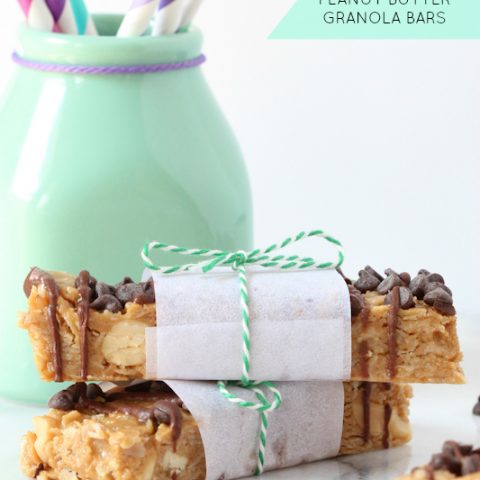
No Bake Chocolate Peanut Butter Granola Bars
Ingredients
- 1 cup peanut butter
- 1/2 cup honey
- 1/2 cup + 1 teaspoon coconut oil, divided
- 2 3/4 cups old fashioned rolled oats
- 3/4 cup chopped peanuts
- 1/4 cup mini chocolate chips
- 1/3 cup semi-sweet chocolate chips
Instructions
- Line a 9-inch square baking dish with parchment paper. Set aside.
- In a medium pot set over low heat, combine the peanut butter, honey, and 1/2 cup coconut oil. Stir until smooth and completely melted. Remove from heat and stir in oats and peanuts. Pour mixture into baking dish, spreading an even layer and pressing down firmly with the back of a spatula. Refrigerate for 10 minutes or until cool. Remove from fridge and sprinkle mini chocolate chips over the top of the mixture, pressing down lightly with the back of a spoon to set in granola. Return to refrigerator and chill 2 hours or until firm. Slice into small bars and remove from pan.
- Melt semi-sweet chocolate chips and one teaspoon coconut oil in a heatproof bowl set over a pot of simmering water. Drizzle melted chocolate over bars and let set. Store granola bars in an airtight container in the refrigerator with wax paper separating the layers.
Notes
*You may also substitute the chocolate chips for a non-dairy alternative.
Connect with Ashley

Blog | Facebook | Twitter | Pinterest | Google + | Instagram


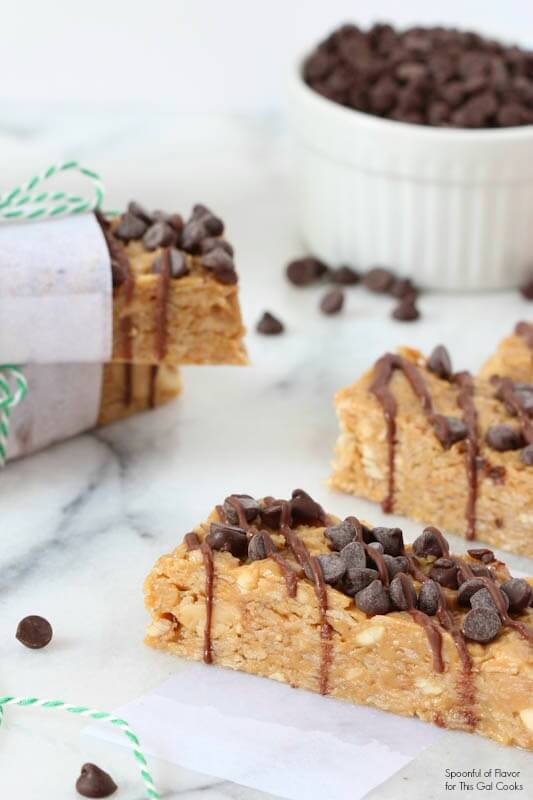
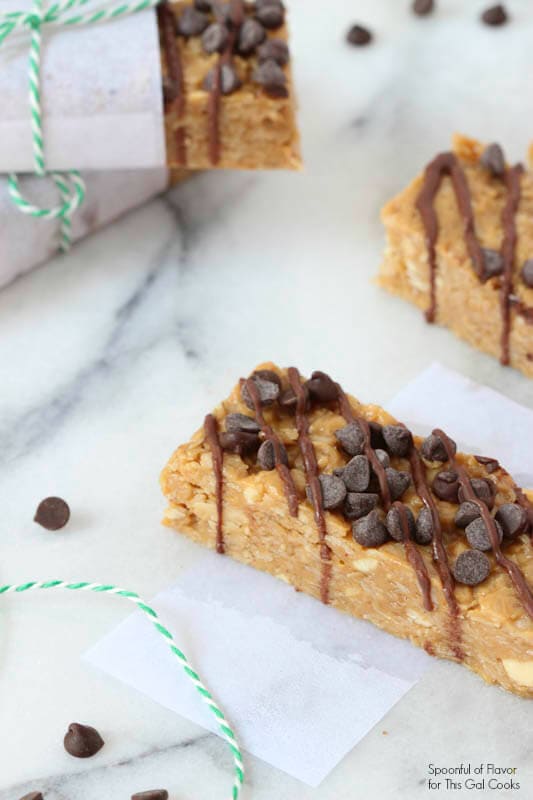
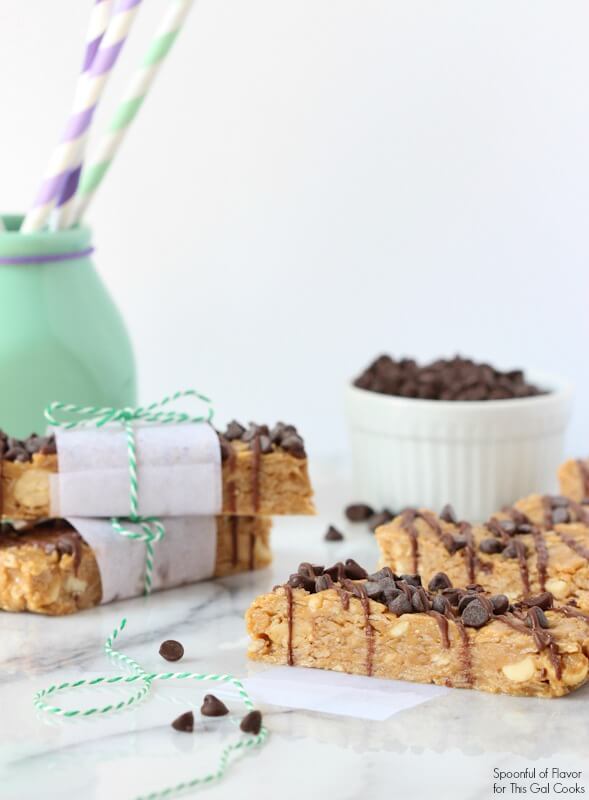
Pingback: No-Bake Chocolate Peanut Butter Granola Bars | Spoonful of FlavorSpoonful of Flavor
Oh wow, Ashley! I have actually never made homemade granola bars yet, but I am pretty sure I am going to start with this recipe. They look delicious! :)
Pinned & sharing!
Thank you for stopping by and checking out Ashley’s recipe, Carrie! These look so good. I need some now!
Oh Ashley these look amazing! I think I know what I’ll make first with my new jar of coconut oil :)
Thank you for stopping by and checking out Ashley’s recipe, Emily! These bars look so darn good and I love using coconut oil. I know what I’m making when I get home from vacation! :)
These look so yummy! Great pictures Ashley! I love that blue vase/cup in the background!
Thanks so much for stopping by, Lindsay! I love these bars that Ashley is sharing today. They look so good! :)
Oh wow, Ashley: your bars came out perfect, and the chocolate + peanut butter combo is one of my very favorites! I need like 34 of these right now. They’d make such a fabulous school snack!
Have a nice day ladies! <3
Thank you so much for stopping by to check out Ashley’s recipe, Consuelo. These bars are definitely a winner! Hope you have great day! :)
These bars are so beautiful!! And look so delicious Ashely!! I know these bars will be a great hit in my house. Thank you Julie for having Ashley over today. Hope you are having a great vacation :)
Thank you, Zainab! Thanks for stopping by and checking out Ashley’s recipe! :)
Yummy looking bars Ashley! I could go for one right now! Hope you are having a good vacation Julie!
Thank you, Deb!
What a great recipe and gorgeous photos, Ashley! I’m not actually a big snacker, but my kids are and would love these!
Thank you so much for stopping by and checking out Ashley’s recipe, Andi! :)
Love these granola bars, they look amazing Ashley! Perfect snack to have on hand and chocolate and peanut butter are an absolute favorite in our house:) Can’t wait to make these! Hope you are having a great vacation so far Julie!
Thank you, Kelly! Having a great vacation. Wish I was 100% better but I’m still having a good time. Thanks for stopping by and checking out Ashley’s recipe! :)
great no-bake bars recipe!
Thank you! :)
YUM, I love these granola bars, Ashley! Pinning. :)
Thank you so much for pinning and for stopping by and checking out Ashley’s recipe, Marcie!
Julie, thank you so much for the opportunity to guest post on your blog! I hope that everyone enjoys these granola bars. I can’t wait to see what Zainab and Gloria have to share later this week. Enjoy your vacation :)
You’re very welcome, Ashley! Thank you SO MUCH for sharing this recipe with my readers. I love it and I can’t wait to try it! :)
Ashley these look delicious!! Thanks for having Ashley over to share with us, Julie! Pinned!
These Bars look amazing! I just love peanut butter and after seeing this I need to make them!
I saw a preview of these on Spoonful of Flavor, they look great to have for breakfast or snack, or just anytime.
these have my name ALL over them!
Ashley I love to make homemade granola bars! Yours look fantastic and I bet taste just as good!!
Pingback: 10 Easy Breakfast Bar Recipes to Start Your Day Right!
Pingback: 10 Fabulous Brownies and Bars | {i love} my disorganized life{i love} my disorganized life
Pingback: Wake Up Wednesdays #25 | The Tasty Fork
Pingback: Wake Up Wednesdays {Week 25} | wine & glue
I love making granola bars with peanut butter, coconut oil and honey, and your addition of peanuts in these sounds delicious! Beautiful pics, too!
Thank you, Samantha! Ashley has some great recipes and I’m so happy that she guest posted last week. If you haven’t already stopped by her blog, you must! You’ll love all of her other recipes. :)
These granola bars are gorgeous! I love Ashley’s blog and of course these look amazing, like all her recipes! Pinning and can’t wait to try!
Thank you, Jen! I love Ashley’s blog as well! Her recipes are great and her photos are lovely. Thanks for stopping by and for the pin. :)
Thank you for stopping by and checking out Ashley’s recipe, Jen!
Not only do those look scrumptious, that is some of the very best food photography I’ve seen. Beautiful job!
Thank you for stopping by and checking out Ashley’s recipe! I’m so glad she guest posted on my blog last week. She has some great recipes and she takes great photos! :)
These are fantastic! We’ve made them several times and each time they are a huge hit!! Our youngest daughter, Sadie, calls these “Sadie Bars” since she eats just about the entire batch!! ;)
So glad that you enjoy these bars, Colleen! And I LOVE it – Sadie Bars. How cute. :)